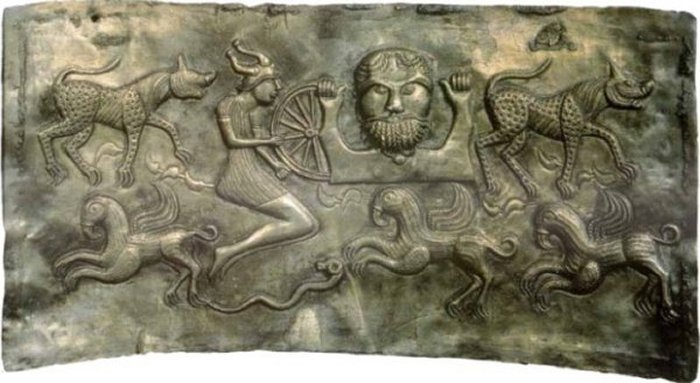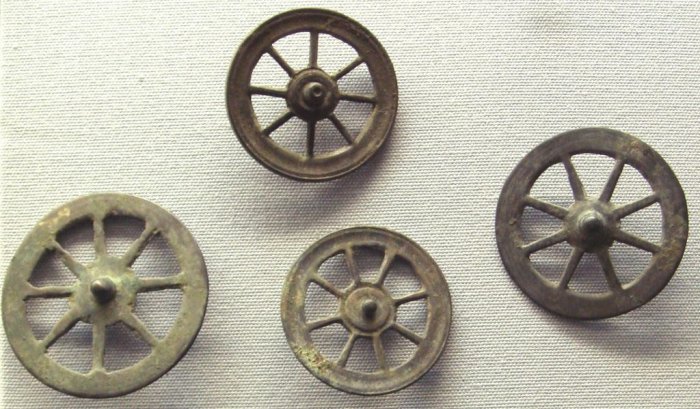Taranis – Celtic God Of Wheel And Thunder Resembled Roman God Jupiter
Ellen Lloyd - AncientPages.com - In Celtic mythology Taranis was the mighty god of thunder. In Welsh and Breton, the word for thunder is taran. Taranis is not as famous as Thor, the Norse god of thunder, Perun, the Slavic god associated with thunder, or Indra, the Vedic god who is frequently depicted holding and using vajra, a terrifying, light-throwing thunderbolt.
Taranis As A Celtic God Of Thunder
Nevertheless, ancient Roman inscriptions reveal that the Celts once worshiped Taranis as a deity with authority over the weather and the sky. He was identified with the ancient Roman god Jupiter, associated with thunder, lightning, and storms. In addition, there is evidence that Taranis was also the Celtic wheel god.
Left: Taranis (Jupiter with wheel and thunderbolt), Le Chatelet, Gourzon, Haute-Marne, France. Credit: Public Domain. Right: Golden Celtic wheel with symbols, Balesme, Haute-Marne. Musée d'Archéologie Nationale. Credit: Public Domain
Archaeological findings have established that Taranis was worshipped not only in Gaul, Britain, and Ireland but also in regions like the Rhineland and the Danube.
It is difficult to determine Taranis's importance, but Lucan, the first Roman poet, considered him one of the three most dominant Celtic deities. Unfortunately, few surviving inscriptions exist, and those that have been found are geographically widespread, making it hard to say how much attention the Celts paid to Taranis.
“At Tours and Orgon (both France) dedications to ‘Thunder’ were probably intended as references to this deity. The same probably applied to dedications to the ‘Thunderer’ at Böckingen and Godramstein (western Germany) and also at Scardona (Croatia).
This last inscription and another from Thauron (France) explicitly equated Taranis with Jupiter.”
“Taranis may also have had connections with the Underworld since a medieval monastic commentator on Lucan (living in Berne, Switzerland) equated Taranis with Dis Pater (or Pluto), the god of the Underworld.” 1
Dangerous Cult Of Taranis
Lucan also explained followers of Taranis belonged to a cruel cult that practiced human sacrifices.
“The human victims were in the first place propitiatory, to appease angry gods, but they were also offered for thanksgiving. Even wives and children were sacrificed before a battle to ensure victory. Prisoners were immolated after a victory in thanksgiving to the gods—Lucan speaks of the cruel sacrifices offered by tribes in Gaul dwelling between the Seine and the Loire to such deities as Teutatis, Esus, and Taranis. Cæsar says that persons in extreme sickness or who are exposed to the perils of war, sacrifice human victims or vow to do so, employing the Druids to carry out the rite.
Gundestrup cauldron, created between 200 BCE and 300 CE, is thought to have a depiction of Taranis on the inner wall of cauldron. Credit: Public Domain.
They believe that unless a life is given for a life the majesty of the immortal gods cannot be appeased. Such sacrifices were made by private individuals or in public ceremonies. He speaks of one public ceremony which for horror cannot be surpassed. Figures of immense size, their limbs made of wicker, were filled with human victims, and set on fire. The victims pleasing to the gods were thieves or other criminals. 2
Taranis was usually depicted as a bearded god with a thunderbolt in one hand and a wheel in the other.
Taranis As A Celtic Wheel God
His connection to the wheel is quite interesting. The wheel was an important Celtic symbol often depicted on coins. Still, it can also be found on the beautiful Gundestrup Cauldron, a magnificent vessel made from richly decorated plates of silver assembled into a single cauldron.
Archaeologists have unearthed thousands of votive wheels called Rouelles in sanctuaries in Belgic Gaul. These ancient artifacts dating from 50 B.C. to 50 C.E. are believed to correspond to the Taranis cult.
One of the reasons why so many votive wheels have been found in sanctuaries is that a wheel could represent a full chariot. As the chariot was the vehicle of the celestial gods, it was also associated with the Sun and Moon.
Votive wheels called Rouelles. Credit: Public Domain
As previously mentioned, many “depictions of the God-of-the-Wheel resemble Jupiter and they bear his attributes of eagle and thunderbolt. The wheel as a symbol is certainly Celtic rather than Roman. Therefore, in both a literary source and in iconography, a Celtic divinity has been “equated” with a classical one. If the Celtic version of Jupiter was named Taranis and if a Celtic attribute appears on archaeological depictions of the Roman god, it seems not unreasonable to suppose that these archaeological representations must symbolize a Celto-Roman deity who was very possibly referred to by his worshippers as “Jupiter-Taranis’”. 3
Very few inscriptions of Taranis have been unearthed, making him a rather obscure god, but it doesn’t necessarily mean he was insignificant to our ancestors.
Updated on March 27, 2024
Written by Ellen Lloyd – AncientPages.com
Copyright © AncientPages.com All rights reserved. This material may not be published, broadcast, rewritten or redistributed in whole or part without the express written permission of AncientPages.com
Expand for references- Whittock, Martyn - A Brief Guide to Celtic Myths and Legends
- A. MacCulloch - The Celtic and Scandinavian Religions
- Green, Miranda. "The Worship of the Romano-Celtic Wheel-God in Britain Seen in Relation to Gaulish Evidence." Latomus38, no. 2 (1979): 345-67.
More From Ancient Pages
-
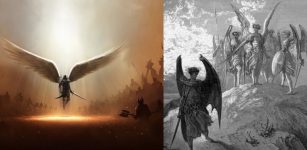 Mystery Of The Watchers And Book Of Enoch – Fallen Angels And Their Secret Knowledge
Biblical Mysteries | Oct 27, 2017
Mystery Of The Watchers And Book Of Enoch – Fallen Angels And Their Secret Knowledge
Biblical Mysteries | Oct 27, 2017 -
 Largest Ancient Embalming Cachette Ever Found Unearthed At Abusir, Egypt
Archaeology | Feb 20, 2022
Largest Ancient Embalming Cachette Ever Found Unearthed At Abusir, Egypt
Archaeology | Feb 20, 2022 -
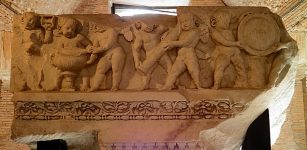 On This Day In History: Julius Caesar Dedicated Temple To Venus Genetrix – On Sep 26, 46 BC
News | Sep 26, 2016
On This Day In History: Julius Caesar Dedicated Temple To Venus Genetrix – On Sep 26, 46 BC
News | Sep 26, 2016 -
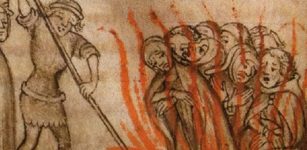 On This Day In History: Knights Templar Arrested – Oct 13, 1307
News | Oct 13, 2015
On This Day In History: Knights Templar Arrested – Oct 13, 1307
News | Oct 13, 2015 -
 Lady Midday – ‘Poludnica’- An Evil, Elusive Female Field-Spirit In Slavic Beliefs That Comes To Kill At Noon
Featured Stories | Jan 7, 2019
Lady Midday – ‘Poludnica’- An Evil, Elusive Female Field-Spirit In Slavic Beliefs That Comes To Kill At Noon
Featured Stories | Jan 7, 2019 -
 Evidence Of Legendary Ancient Great Flood In China May Re-Write History
Chinese Mythology | Aug 5, 2016
Evidence Of Legendary Ancient Great Flood In China May Re-Write History
Chinese Mythology | Aug 5, 2016 -
 Terrace Farming Was Invented In South American Andes Over 1,000 Years Ago
Ancient History Facts | Sep 7, 2016
Terrace Farming Was Invented In South American Andes Over 1,000 Years Ago
Ancient History Facts | Sep 7, 2016 -
 Robert Fortune’s Dangerous Mission To Obtain Tea From The Chinese
Featured Stories | Feb 24, 2020
Robert Fortune’s Dangerous Mission To Obtain Tea From The Chinese
Featured Stories | Feb 24, 2020 -
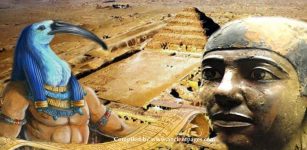 Did Mastermind Imhotep Receive Sacred Knowledge From Followers Of Horus At Heliopolis?
Featured Stories | Feb 7, 2018
Did Mastermind Imhotep Receive Sacred Knowledge From Followers Of Horus At Heliopolis?
Featured Stories | Feb 7, 2018 -
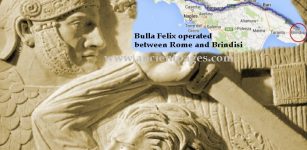 Bulla Felix: Legendary Italian Leader Of Outlaws Who Robbed The Rich And Gave To The Poor
Featured Stories | Mar 23, 2023
Bulla Felix: Legendary Italian Leader Of Outlaws Who Robbed The Rich And Gave To The Poor
Featured Stories | Mar 23, 2023 -
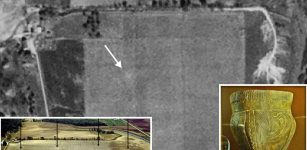 Long-Lost Ancient Burial Mounds Of The Havana Hopewell Culture Re-Discovered In Iowa
Archaeology | Apr 6, 2021
Long-Lost Ancient Burial Mounds Of The Havana Hopewell Culture Re-Discovered In Iowa
Archaeology | Apr 6, 2021 -
 Clurichaun – Little Naughty And Drunken Fellow Akin To Leprechaun In Irish Folklore
Featured Stories | Sep 13, 2019
Clurichaun – Little Naughty And Drunken Fellow Akin To Leprechaun In Irish Folklore
Featured Stories | Sep 13, 2019 -
 Rare 13,000-Year-Old Artifacts And Paleoindian Camp Uncovered in Connecticut Shed New Light On The First Ancient People In America
Archaeology | Mar 18, 2022
Rare 13,000-Year-Old Artifacts And Paleoindian Camp Uncovered in Connecticut Shed New Light On The First Ancient People In America
Archaeology | Mar 18, 2022 -
 Ancient Wooden Sculpture Unearthed In Peru’s Chan Chan
Archaeology | Jul 12, 2022
Ancient Wooden Sculpture Unearthed In Peru’s Chan Chan
Archaeology | Jul 12, 2022 -
 Ancient Syriac Epitaphs Discovered In Tomb Of Priest Monoha Shed New Light On The Assyrian Empire
Archaeology | Dec 23, 2019
Ancient Syriac Epitaphs Discovered In Tomb Of Priest Monoha Shed New Light On The Assyrian Empire
Archaeology | Dec 23, 2019 -
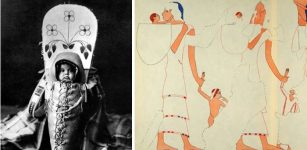 Baby Carriers Were Used 10,000 Years Ago – New Evidence
Archaeology | Sep 27, 2022
Baby Carriers Were Used 10,000 Years Ago – New Evidence
Archaeology | Sep 27, 2022 -
 Clues What Tiggered Climate Change 8,000 Years Ago Found In Scotland
News | Sep 15, 2023
Clues What Tiggered Climate Change 8,000 Years Ago Found In Scotland
News | Sep 15, 2023 -
 Neanderthals’ Lack Of Drawing Ability Could Explain Why Modern Humans Became Smarter
Archaeology | Feb 11, 2018
Neanderthals’ Lack Of Drawing Ability Could Explain Why Modern Humans Became Smarter
Archaeology | Feb 11, 2018 -
 4,000-Year-Old Stonehenge Of The Netherlands Reveals Its Secrets
Archaeology | Jun 22, 2023
4,000-Year-Old Stonehenge Of The Netherlands Reveals Its Secrets
Archaeology | Jun 22, 2023 -
 Ancient Ritual Bundle From Bolivia Reveals Multiple Psychotropic Plants
Archaeology | May 7, 2019
Ancient Ritual Bundle From Bolivia Reveals Multiple Psychotropic Plants
Archaeology | May 7, 2019


